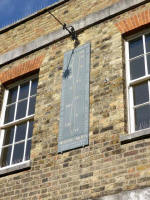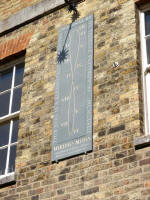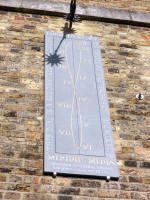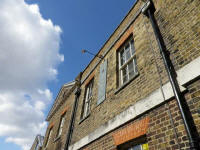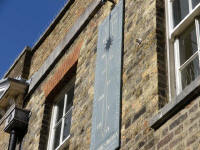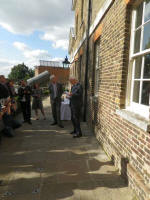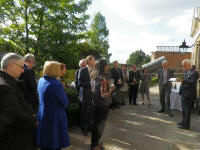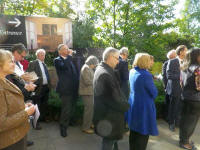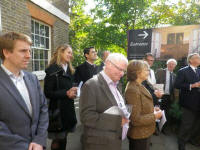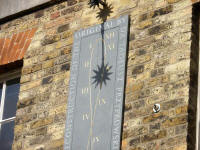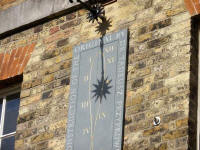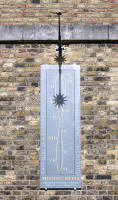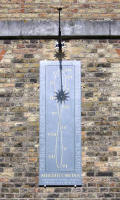Dedication of the Greenwich Diamond Jubilee
Dial
10th October 2012
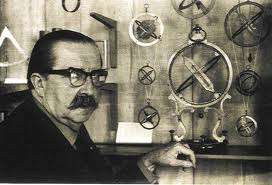 In 1969 the 'Meridies Media' noon mark mean time
sundial, designed by Polish scientist Dr Tadeusz Przypkowski (1905-1977,
pictured) and with some amendments by Christopher Daniel, was installed on the south wall of the Meridian
Building in what was then the Old Royal Observatory at Greenwich. Dr Przypkowski
was a renowned bibliophile, a lover of graphics and heraldry , photographer,
author bookplate collector and at the time, one of the few specialists in
sundials and their design and was much sought after for this skill. He came to London during the war
where he became known and after the
war ended he returned to Jędrzejów, taking up private scientific and cultural
activities. It was during this time that he was asked to design the original
Greenwich noon mark as well as several other dials for the same location.
In 1969 the 'Meridies Media' noon mark mean time
sundial, designed by Polish scientist Dr Tadeusz Przypkowski (1905-1977,
pictured) and with some amendments by Christopher Daniel, was installed on the south wall of the Meridian
Building in what was then the Old Royal Observatory at Greenwich. Dr Przypkowski
was a renowned bibliophile, a lover of graphics and heraldry , photographer,
author bookplate collector and at the time, one of the few specialists in
sundials and their design and was much sought after for this skill. He came to London during the war
where he became known and after the
war ended he returned to Jędrzejów, taking up private scientific and cultural
activities. It was during this time that he was asked to design the original
Greenwich noon mark as well as several other dials for the same location.
The noon mark was constructed using an iron gnomon but was sadly made by
the then Ministry of Works using wood for the dial
plate. Over the years the dial plate deteriorated and had to be taken
down. In 2009 a movement was started to reinstate a replica. Christopher Daniel, who
had been curator of the sundial collection of the National Maritime Museum at
the time of the original installation, was asked to delineate the replacement. This
he has most generously undertaken without a fee. The new dial is in slate
but uses the original gnomon. The
carving has been excellently done by Ben Jones of Exeter - himself also a BSS
Member. Like Christopher's famous Dolphin dial this one commemorates a Royal
Jubilee; in this case HM the Queen's Diamond Jubilee of 2012.
The dial was formally opened by BSS Patron Sir Mark Lennox Boyd
on Wednesday 10.10.12 at 12:30pm at a small gathering both of those who had
subscribed toward the £7,000 cost of the replacement and its installation and of
staff of the Museum. Christopher Daniel then gave the following address:
"Designing a sundial seems akin to composing a
piece of orchestral music, such as a piano concerto, which involves many others
in the orchestra, quite apart from the conductor and the pianist. In my
designing career, I quickly learned to commission the very best sculptors,
artists and craftsmen for my “orchestra”, notwithstanding the expense. In this
case, there are many in the “orchestra” who deserve recognition for their
contribution to this work and my heartfelt thanks.
Following discussions with Douglas Bateman, it was Dr Gloria Clifton’s idea to
have Dr Tadeusz Przypkowski’ s sundial, originally designed in 1967 and set up
in 1968, restored or rather reconstructed, to mark Her Majesty the Queen’s
Diamond Jubilee. Many of you will know that it was this Meridies Media dial that
first caused me to become interested in sundials and to go on to designing them
myself over the years, notably the “dolphin” sundial to mark the Queen’s Silver
Jubilee.
To day, I should like to thank Sir Mark Lennox-Boyd, Patron of the British
Sundial Society and a distinguished sundial designer himself, for carrying out
this ceremony at the invitation of the Director, Dr Kevin Fewster; my thanks
also to Dr Gloria Clifton and Rebekah Higgitt for their help and encouragement;
to my partner, Doreen Bowyer, for her constant help and support; to all those
who contributed so generously to the sundial fund; Lucy Cooke, in particular,
who administered the Appeal and who has organised this event today; Clive
Sherwood, stone mason, and Tony Lowe, site manager, who gave invaluable
assistance with the installation of the sundial, in difficult weather
conditions; Richard Riddick and David Cutts of the DPC for valuable photographic
work; and those ROG staff, notably Jim Whadams, who so willingly gave their help
to our team. This was the “orchestra.” However, most important of all, is the
“pianist” – the one who deserves the most applause, who brought this work of
scientific art to such elegant “life” and beauty… namely Ben Jones..! He has my
warmest thanks and appreciation; but, to all those involved – my thanks to you
all".
Asked about his own presence at the opening, Patrick Powers said he was simply
one of several donors interested to see something like this reinstated; although
he had in a very small way, also been pleased to add his weight to the clamour
for Roman numerals to be used to identify the months (as had been done in the
case of the original dial) rather than for Arabic ones to be used instead.
In a nice touch to mark the occasion of the reinstated replica and
to recognise Dr Przypkowski's contribution, the event was attended by a
representative of the Przypkowski Museum in Jędrzejowo, Rafał Zaczkowski
and two Polish sundial enthusiasts, Elżbiet a Niedbałka and BSS Member
Dariusz Oczki. The British Sundial Society - itself a significant donor - was represented at the event by
one of the charity's trustees, Mr John Foad and of course by the Society's
President, Christopher Daniel and its Patron, Sir Mark Lennox-Boyd.
The noon mark uses a pierced shadow plate gnomon with the resulting
spot of light being the indicator of time. We were so lucky that the sun
shone on the day!! The images below show the dial as the donors gathered
for the ceremony and as the sun's spot began to travel left to right across
the dialplate. Then we see some shots of the ceremony itself followed by
more of the dial as the spot of light came to the analemma and marked Noon BST.
Click on any image to see an enlarged version.
Finally, for those who may be interested,
here is an image of the
front page of the handout, courtesy Christopher Daniel 2012. It may help further to
explain the operation of this lovely noon mark.
[back]
19.10.12/ 27.10.12
 In 1969 the 'Meridies Media' noon mark mean time
sundial, designed by Polish scientist Dr Tadeusz Przypkowski (1905-1977,
pictured) and with some amendments by Christopher Daniel, was installed on the south wall of the Meridian
Building in what was then the Old Royal Observatory at Greenwich. Dr Przypkowski
was a renowned bibliophile, a lover of graphics and heraldry , photographer,
author bookplate collector and at the time, one of the few specialists in
sundials and their design and was much sought after for this skill. He came to London during the war
where he became known and after the
war ended he returned to Jędrzejów, taking up private scientific and cultural
activities. It was during this time that he was asked to design the original
Greenwich noon mark as well as several other dials for the same location.
In 1969 the 'Meridies Media' noon mark mean time
sundial, designed by Polish scientist Dr Tadeusz Przypkowski (1905-1977,
pictured) and with some amendments by Christopher Daniel, was installed on the south wall of the Meridian
Building in what was then the Old Royal Observatory at Greenwich. Dr Przypkowski
was a renowned bibliophile, a lover of graphics and heraldry , photographer,
author bookplate collector and at the time, one of the few specialists in
sundials and their design and was much sought after for this skill. He came to London during the war
where he became known and after the
war ended he returned to Jędrzejów, taking up private scientific and cultural
activities. It was during this time that he was asked to design the original
Greenwich noon mark as well as several other dials for the same location.